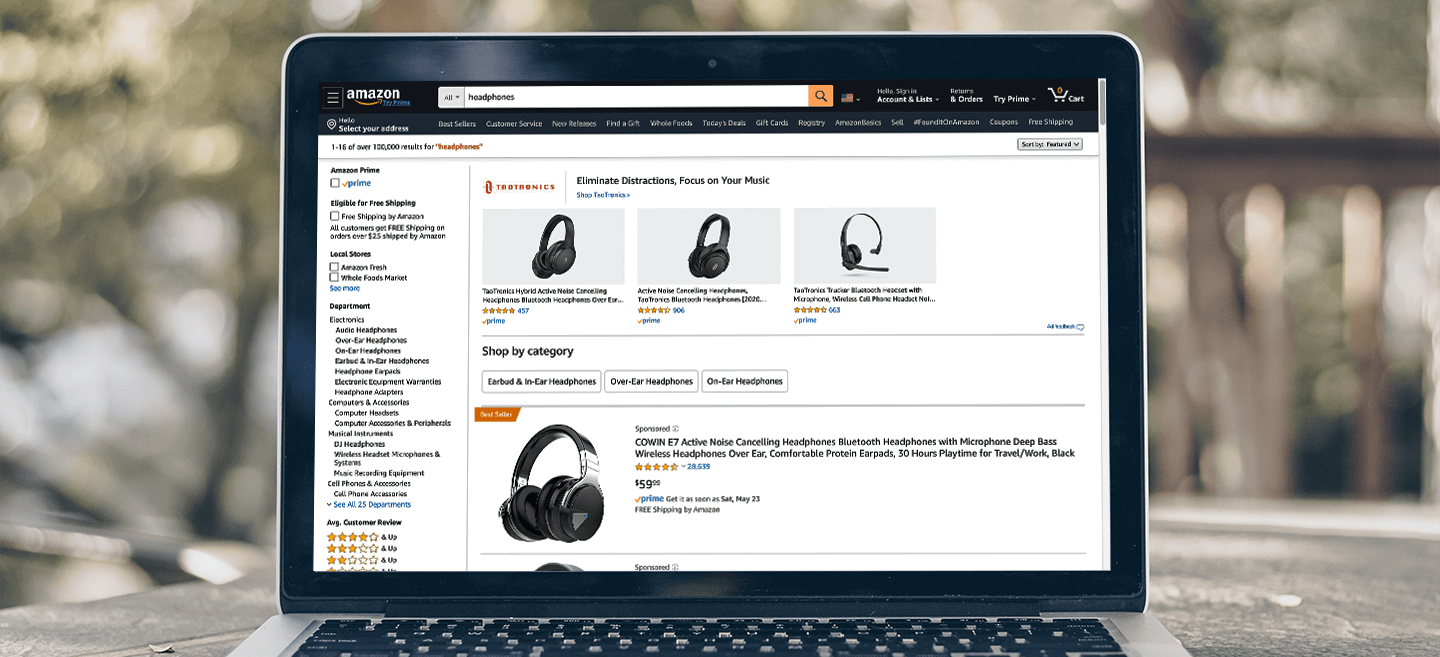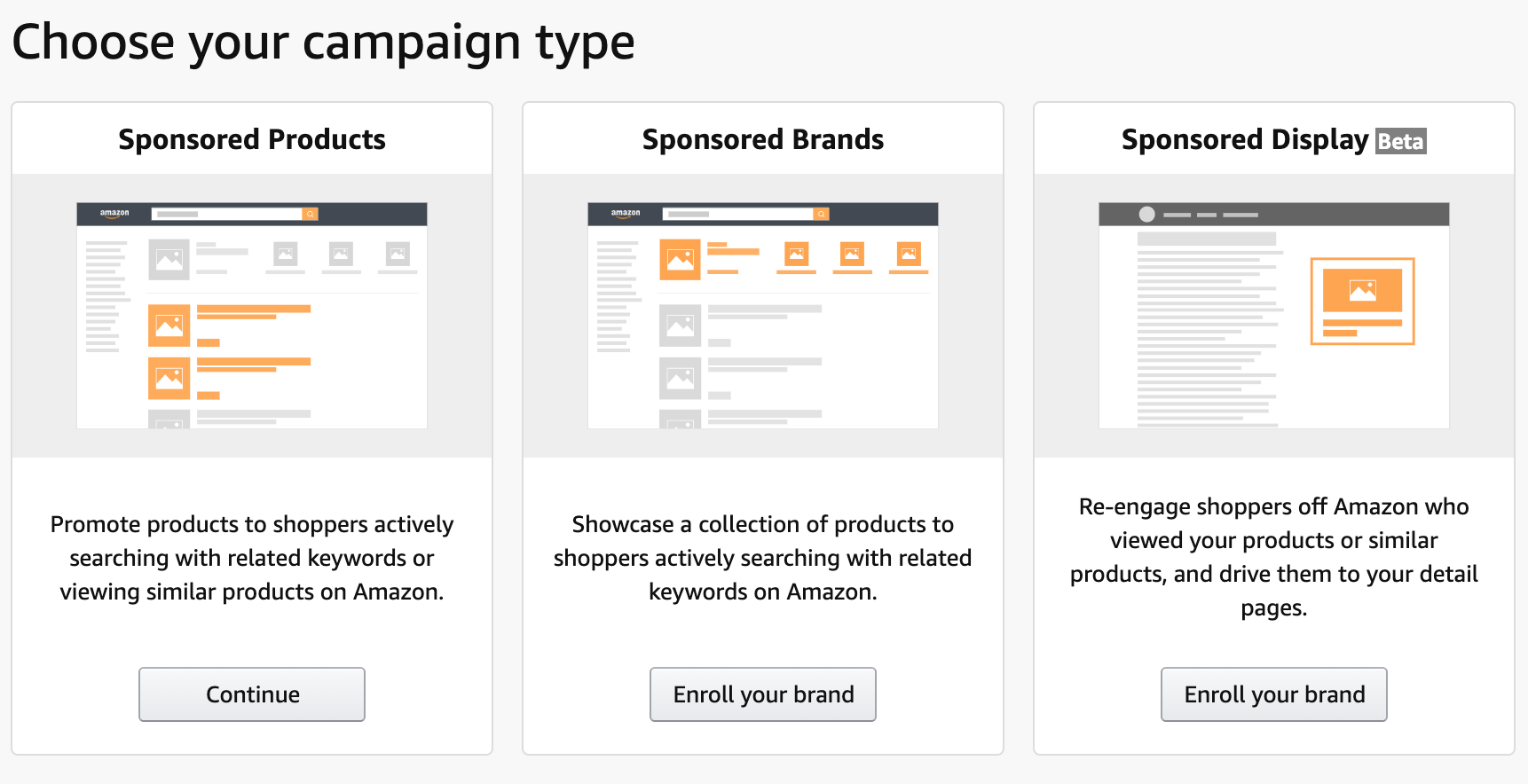
Tips to Help Marketers with Amazon Ads
There’s a lot to unlock from Amazon Ads. Industry experts shared their knowledge and strategies with us, and we think you’ll find several useful ideas for using Amazon Ads. Tips include how to protect your brand, which campaign types to use, and what new ad types can offer.

Rakesh Reddy
Co-Founder, Purple Carrot Media Pvt. Ltd
Familiarize yourself with all the different options Amazon offers for ads.
Amazon advertising has different products that offer different placements to advertise a brand. The most common advertising products from Amazon are Sponsored Products, Sponsored Brands and Sponsored Display. All three of these products are available as self-service platforms like Google and Facebook, where any Seller Central user with Advertising permissions can set up the campaign.

In the above image, you can see the three different products from Amazon advertising. Sponsored Products is available to every seller to advertise the products on Amazon. Sponsored Brands and Sponsored Display are available to the Registered Brands under Amazon through the Brand Registry. In order to register a Brand, one must have Trademark registration for the brand.
Sponsored Products (SP)
This advertising product is used to Promote products to shoppers actively searching with related keywords or viewing similar products on Amazon.
Sponsored Brands (SB)
This advertising product is used to Showcase a collection of products to shoppers actively searching with related keywords on Amazon.
Sponsored Display
This is a remarketing campaign that helps brands to re-engage the users off Amazon who viewed products. This campaign drives the traffic back to the listings. This product is still in Beta.
Since it is a remarketing campaign, we just need to plug in the listings and the campaign will automatically serve the impressions.
The only factor that we can control is the bidding. Based on the ACoS (Advertising Cost of Sale), we can either increase or decrease the bidding.
Amazon has a bunch of other promotion options for sellers:
Early Reviewer Program—get first reviews faster.
- This program helps sellers get up to 5 reviews by offering customers who purchased enrolled items a small reward ($3 Gift Card) in exchange for providing feedback on your product
- This is a great feature by Amazon that helps in optimising the listing and developing the trust among customers
Deals—there are two types of deals:
- Lightning Deals are flash sales where a product is featured for several hours on the Amazon Deals page, one of the most visited pages on Amazon.
- 7-day Deals are also featured on the Amazon Deals page for up to 7 days at a time. Sellers need to enroll SKUs prior to the launch date. Amazon will charge a fee to enroll in this program.

Alec Burns
Lead Amazon Strategist, Fluid Digital
Manage your keywords and bids carefully.
Account Structure
Most commonly you’d choose to organise by product type, but sometimes by targeting method makes more sense. In any case, it will help to make campaigns easier to identify, avoid conflict in your account, as well as making reporting much faster and more insightful.
Granular Bidding for Automatic Campaigns
Automatic campaigns have four match types: close match, loose match, substitutes and complements. Performance of each often varies dramatically, so the bids should be managed per match type rather than at ad group level.
Isolate the Best and Worst Performers
Use the search term report to find the queries that generate sales and target them manually. This gives you control over how you bid for these keywords in order to maximise returns, especially during high traffic periods like Black Friday when you’ll want to bid aggressively.
You should also isolate the worst performing queries. If performance is truly awful then add it as a negative. However, if a query generates sales but at a poor ACoS, you can target it manually on a lower bid to generate sales more profitably.
Ensure Targeted Keywords are Included in Your Content
One of the factors in the ad rank is keyword relevance, not only of the keyword to the search query, but also to the product advertised. It’s not always possible to include absolutely every keyword targeted if you have an extensive list, but you should ensure that your top keywords are also in your content.
Make Use of Category and ASIN Targeting
Product targeting allows you to target to an entire category, specific competitors or specific products. If these targeting methods are yet unexplored for you, they present a new opportunity for growth.

Carlos Miguel Medina Ruvalcaba
Online Marketing Specialist, Wonder Workshop
Protect your brand and your ASINs.
Brand protection
It is vital for you to advertise targeting your own listings (ASINs) to avoid letting competitors steal your traffic. You can do this using any type of campaign (sponsored product, sponsored brands, sponsored display).
- Create portfolios to distribute your campaigns by intention. For example, one portfolio can contain only branded campaigns targeting.
- Reporting and keywords optimization.
Pull the Sponsored Product and Sponsored Brand search terms reports at least once a month, look for what search terms bring you higher-quality traffic to your campaigns. Add these search terms as Exact Match Keywords to your campaigns.
Also, use search terms reports to find keywords leading undesired traffic to your listings. Add these search terms as negative keywords to your campaigns.
Sponsored Products, Manual Targeting.
Historically this is the best performing type of campaign on Amazon Advertising, and you should play with these technical settings:
- Campaign settings > bidding strategy.
- If you have limited campaign budget, try “Dynamic Bids – down only.”
- If you have large budgets try “Dynamic Bids – up and down.” AB testing is advised.
- Campaign settings > Adjust Bids by Placement.
- Consider increasing your bids to appear whether on the top of the search (first page) or Product Pages.

Duff Ferguson
Partner/Founder, Amplitude Digital Inc.
Try out the new ad types.
Amazon sellers take note: 2020 is the year of the advertiser! But you won’t be alone. Expect more competition and higher costs to keep coming. On the flip side, there are plenty of new opportunities to capture sales in new ways.
Consumers and sellers today must live with an Amazon search page real estate that is covered in sponsored ads. Normal product listings languish below the fold. This is a major reason why paid ads now generate over 25% of total Amazon sales! Google and Facebook are losing advertising market share to Amazon every year.
Despite all the new inventory available, average cost-per-click on Amazon is actually 40-50% higher than 2018. That raises the ante: advertisers have to be more focused in their delivery and smarter in their targeting.
In addition to the usual Sponsored Ads and Headline Ads, there are new ad types available.
You are no longer limited to advertising on the Amazon platform! Try new sponsored display ads that show both on and off Amazon to retarget undecided customers with energizing followup. Another new bonus: Amazon video ads on mobile. Experiments have shown high ROI and increased engagement.
The same best practices for Amazon still apply: optimize campaign structure and bidding, research and choose the best keywords, optimize listings, maximize brand store content and encourage great reviews.
Data crunchers will have plenty to enjoy in 2020. Big upgrades in Amazon data and insights are expected. With Amazon hoovering up almost 50% of all US e-commerce sales, that data will be very valuable.
Smart growth marketing tactics are more important than ever on Amazon. Make sure you utilize all these new opportunities to grow and dominate in your niche!
Related Content

Content Marketing Tips to Help Tap into Your Audience

eCommerce Marketing Tips to Drive More Online Sales
